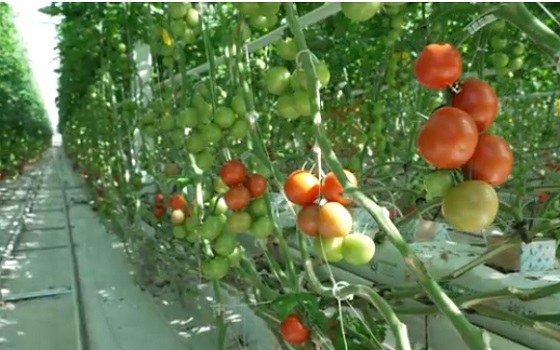Agriculture
Province announces massive commitments to rural Alberta

Building up the rural Alberta economy
Alberta’s government has unveiled a plan to drive economic growth and address challenges unique to rural communities.
Rural Alberta is a driving force in the economy and the new Economic Development in Rural Alberta Plan will complement current government initiatives while supporting diversification and job opportunities in rural communities.
The five-year plan focuses on key issues in rural Alberta, including economic development-enabling infrastructure, rural business supports and entrepreneurship, support for labour force and skills development, marketing and promoting rural tourism, and rural economic development capacity building.
“Rural Albertans face unique economic barriers and challenges that require a different approach than their urban neighbours. The Economic Development in Rural Alberta Plan charts a path forward that will address these issues and build on our commitment in Budget 2022 to support sustainable growth and diversification in rural Alberta.”
As one of the first tangible actions under the plan, the government has committed $125,000 to each of the eight regional economic development alliances to support long-term economic prosperity in their respective regions.
“With strengths in oil and gas, agriculture and forestry, tourism and emerging technologies, Alberta’s rural and northern communities are the backbone of our province’s economy. Actions identified in this plan will benefit rural and northern Albertans for years to come, including providing additional support to Alberta’s network of regional economic development alliances to fuel further economic growth and prosperity across our province.”
The Announcement
Engaging with rural Albertans
The plan was created after a year of consultations. Beginning in fall 2021, Alberta’s government held targeted sessions with rural Alberta businesses and communities, in addition to Indigenous communities, to identify the specific challenges and possible solutions facing their regions.
In total, government hosted 23 virtual engagement sessions with more than 370 rural Albertans, businesses and communities, receiving 3,500 comments. At the same time, an online survey was conducted, which received an additional 919 responses.
Feedback from the sessions and the online survey helped develop the plan’s vision, guiding principles and strategic directions. These were refined and validated through a second phase of targeted engagement with the same individuals and groups in summer 2022.
“Regional economic development alliances are strategically structured to collaborate with governments to address key issues in rural Alberta. Our first step is to identify and improve economic development and enable infrastructure to support investment and growth in rural Alberta. Once we initiate this step, we can further support rural businesses, increase the labour force and market a stronger rural Alberta to Canada and the rest of the world. We look forward to moving forward with the Economic Development in Rural Alberta Plan and continued collaboration with the Government of Alberta.”
“As a leading advocate for our province’s towns and villages, Alberta Municipalities is pleased to see the provincial government focus on the unique needs of Alberta’s smaller and more remote communities. We welcome efforts to grow and diversify our province’s economy, including renewed support for regional economic development alliances.”
“For well over a century the Rural Municipalities of Alberta has helped rural municipalities achieve strong, effective, local government. The Economic Development in Rural Alberta Plan supports our mission to strengthen rural Alberta and cultivate strategic and collaborative partnerships. This plan starts today and is designed for the rural Alberta of tomorrow.”
Quick facts
- The plan focuses on five key strategic directions:
- Identifying and improving economic development-enabling infrastructure to support investment and growth in rural Alberta.
- Advancing entrepreneurship capacity and a culture of innovation across rural Alberta.
- Enabling skills development in rural communities to enhance workforce capacity today and for the future.
- Enhancing rural Alberta’s reputation and capacity as a diverse tourism destination.
- Enhancing rural economic development through regional and targeted capacity building.
- The plan will complement a number of initiatives that demonstrate the government’s commitment to building healthy and prosperous communities across rural Alberta, including:
- Up to $390 million over four years as part of the Alberta Broadband Strategy to eliminate the digital divide for all Albertans.
- Nearly $933 million for irrigation infrastructure in partnership with nine irrigation districts to expand and modernize Alberta’s irrigation infrastructure.
- $78 million to fund 133 active capital maintenance and renewal projects in rural Alberta communities.
- A $59-million investment to expand veterinary medicine at the University of Calgary, doubling the number of seats in the program to address a critical shortage of large animal veterinarians in rural Alberta.
- $70 million for the Film and Television Tax Credit that will attract major productions to the province, diversifying the economy and creating thousands of new jobs.
- More than $8 million through the Indigenous Opportunities Corporation to support Indigenous communities’ participation in commercially viable resource projects to support rural economic growth.
Agriculture
Growing Alberta’s fresh food future

A new program funded by the Sustainable Canadian Agricultural Partnership will accelerate expansion in Alberta greenhouses and vertical farms.
Albertans want to keep their hard-earned money in the province and support producers by choosing locally grown, high-quality produce. The new three-year, $10-milllion Growing Greenhouses program aims to stimulate industry growth and provide fresh fruit and vegetables to Albertans throughout the year.
“Everything our ministry does is about ensuring Albertans have secure access to safe, high-quality food. We are continually working to build resilience and sustainability into our food production systems, increase opportunities for producers and processors, create jobs and feed Albertans. This new program will fund technologies that increase food production and improve energy efficiency.”
“Through this investment, we’re supporting Alberta’s growers and ensuring Canadians have access to fresh, locally-grown fruits and vegetables on grocery shelves year-round. This program strengthens local communities, drives innovation, and creates new opportunities for agricultural entrepreneurs, reinforcing Canada’s food system and economy.”
The Growing Greenhouses program supports the controlled environment agriculture sector with new construction or expansion improvements to existing greenhouses and vertical farms that produce food at a commercial scale. It also aligns with Alberta’s Buy Local initiative launched this year as consumers will be able to purchase more local produce all year-round.
The program was created in alignment with the needs identified by the greenhouse sector, with a goal to reduce seasonal import reliance entering fall, which increases fruit and vegetable prices.
“This program is a game-changer for Alberta’s greenhouse sector. By investing in expansion and innovation, we can grow more fresh produce year-round, reduce reliance on imports, and strengthen food security for Albertans. Our growers are ready to meet the demand with sustainable, locally grown vegetables and fruits, and this support ensures we can do so while creating new jobs and opportunities in communities across the province. We are very grateful to the Governments of Canada and Alberta for this investment in our sector and for working collaboratively with us.”
Sustainable Canadian Agricultural Partnership (Sustainable CAP)
Sustainable CAP is a five-year, $3.5-billion investment by federal, provincial and territorial governments to strengthen competitiveness, innovation and resiliency in Canada’s agriculture, agri-food and agri-based products sector. This includes $1 billion in federal programs and activities and $2.5 billion that is cost-shared 60 per cent federally and 40 per cent provincially/territorially for programs that are designed and delivered by provinces and territories.
Quick facts
- Alberta’s greenhouse sector ranks fourth in Canada:
- 195 greenhouses produce $145 million in produce and 60 per cent of them operate year-round.
- Greenhouse food production is growing by 6.2 per cent annually.
- Alberta imports $349 million in fresh produce annually.
- The program supports sector growth by investing in renewable and efficient energy systems, advanced lighting systems, energy-saving construction, and automation and robotics systems.
Related information
Agriculture
Canada’s air quality among the best in the world

From the Fraser Institute
By Annika Segelhorst and Elmira Aliakbari
Canadians care about the environment and breathing clean air. In 2023, the share of Canadians concerned about the state of outdoor air quality was 7 in 10, according to survey results from Abacus Data. Yet Canada outperforms most comparable high-income countries on air quality, suggesting a gap between public perception and empirical reality. Overall, Canada ranks 8th for air quality among 31 high-income countries, according to our recent study published by the Fraser Institute.
A key determinant of air quality is the presence of tiny solid particles and liquid droplets floating in the air, known as particulates. The smallest of these particles, known as fine particulate matter, are especially hazardous, as they can penetrate deep into a person’s lungs, enter the blood stream and harm our health.
Exposure to fine particulate matter stems from both natural and human sources. Natural events such as wildfires, dust storms and volcanic eruptions can release particles into the air that can travel thousands of kilometres. Other sources of particulate pollution originate from human activities such as the combustion of fossil fuels in automobiles and during industrial processes.
The World Health Organization (WHO) and the Canadian Council of Ministers of the Environment (CCME) publish air quality guidelines related to health, which we used to measure and rank 31 high-income countries on air quality.
Using data from 2022 (the latest year of consistently available data), our study assessed air quality based on three measures related to particulate pollution: (1) average exposure, (2) share of the population at risk, and (3) estimated health impacts.
The first measure, average exposure, reflects the average level of outdoor particle pollution people are exposed to over a year. Among 31 high-income countries, Canadians had the 5th-lowest average exposure to particulate pollution.
Next, the study considered the proportion of each country’s population that experienced an annual average level of fine particle pollution greater than the WHO’s air quality guideline. Only 2 per cent of Canadians were exposed to fine particle pollution levels exceeding the WHO guideline for annual exposure, ranking 9th of 31 countries. In other words, 98 per cent of Canadians were not exposed to fine particulate pollution levels exceeding health guidelines.
Finally, the study reviewed estimates of illness and mortality associated with fine particle pollution in each country. Canada had the fifth-lowest estimated death and illness burden due to fine particle pollution.
Taken together, the results show that Canada stands out as a global leader on clean air, ranking 8th overall for air quality among high-income countries.
Canada’s record underscores both the progress made in achieving cleaner air and the quality of life our clean air supports.
-

 National2 days ago
National2 days agoLiberal bill “targets Christians” by removing religious exemption in hate-speech law
-

 C2C Journal17 hours ago
C2C Journal17 hours agoWisdom of Our Elders: The Contempt for Memory in Canadian Indigenous Policy
-

 Crime2 days ago
Crime2 days agoInside the Fortified Sinaloa-Linked Compound Canada Still Can’t Seize After 12 Years of Legal War
-

 Business2 days ago
Business2 days agoLooks like the Liberals don’t support their own Pipeline MOU
-

 Business1 day ago
Business1 day agoConservative MP warns Liberals’ national AI plan could increase gov’t surveillance
-

 Business2 days ago
Business2 days agoCanada Can Finally Profit From LNG If Ottawa Stops Dragging Its Feet
-

 Alberta17 hours ago
Alberta17 hours agoAlberta introducing three “all-season resort areas” to provide more summer activities in Alberta’s mountain parks
-

 Business1 day ago
Business1 day agoStorm clouds of uncertainty as BC courts deal another blow to industry and investment





